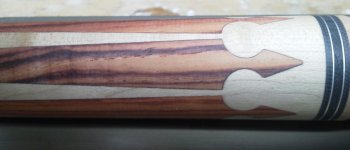I’m setting up to cut some floating forearm points & I’m seeing an old friend again. I’m going .135” deep @ the base since I don’t have a Z offset to level the cue on my homegrown machine. I’m getting a nasty fishhook at the base point of my test pieces on my finish .003 pass. Doesn’t seem to matter CW or CCW. I get my best cutting performance running my machine @ 15 IPM roughing and 4 to 8 IPM finishing. I don’t see this problem on shallow pockets.
The max depth of cut on my Ø.031” carbide 3 flute mill is .165”. I think I’ll order some 3 flute .140” DOC to see if I get less cutter deflection into the deep pocket corner. Or I could try a 2 flute .130 DOC even though I’m cutting .135 deep. Dick mentioned quite a few coons ages ago that the curf makes a nice lead in.
From earlier conversations I believe I’m using the best cutter supplier out there, I’m just thinking I may not be using the right tool for the job?
The max depth of cut on my Ø.031” carbide 3 flute mill is .165”. I think I’ll order some 3 flute .140” DOC to see if I get less cutter deflection into the deep pocket corner. Or I could try a 2 flute .130 DOC even though I’m cutting .135 deep. Dick mentioned quite a few coons ages ago that the curf makes a nice lead in.
From earlier conversations I believe I’m using the best cutter supplier out there, I’m just thinking I may not be using the right tool for the job?
